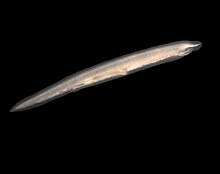Cephalochordata
| Cephalochordate Temporal range: Early Cambrian–Recent |
|
|---|---|
 |
|
| A Branchiostoma lanceolatum lancelet | |
| Scientific classification | |
| Kingdom: | Animalia |
| Phylum: | Chordata |
| Subphylum: |
Cephalochordata Haeckel, 1866 |
| Groups | |
|
|
| Synonyms | |
|
|
A cephalochordate (from Greek: κεφαλή kephalé, "head" and χορδή khordé, "chord") is an animal in the chordate subphylum, Cephalochordata. They are characterized as chordates, as they possess all 5 of the chordate characteristics during larval stages and through to adulthood. This includes: notocord, dorsal nerve cord, endostyle, pharynx and post-anal tail. Cephalochordates are represented in the modern oceans by the Amphioxiformes (lancelets, also known as amphioxus). Along with its sister phylum, Urochordata, Cephalochordata can be classified as belonging to the taxon .
The characteristics of Cephalochordata are that they are segmented marine animals that possess elongated bodies with a notochord that extends the length of the body, extending from head to tail, persisting throughout the animal's life. The members of this subphylum are very small and have no hard parts, making their fossils difficult to find. Fossilized species have been found in very old rocks predating vertebrates. There is a famous fossil shale from the Middle Cambrian, the Burgess Shale of British Columbia, which has yielded Pikaia fossils. Recently, a different cephalochordate fossil (Yunnanozoon) has been found in south China. It dates to the early Cambrian period, and is the earliest known fossil of the cephalochordate lineage. Members of this lineage have numerous gill slits, and have separate sexes.
Phylogeny is based on a combination of studies of extinct and extant species.
†Pikaia gracilens Walcott 1911
†Cathaymyrus Shu, Conway Morris & Zhang 1996
†Paleobranchiostoma hamatotergum Oelofsen & Loock 1981
Asymmetron Peters 1876
Epigonichthys Andrews 1893
Branchiostoma Costa 1834
...
Wikipedia
